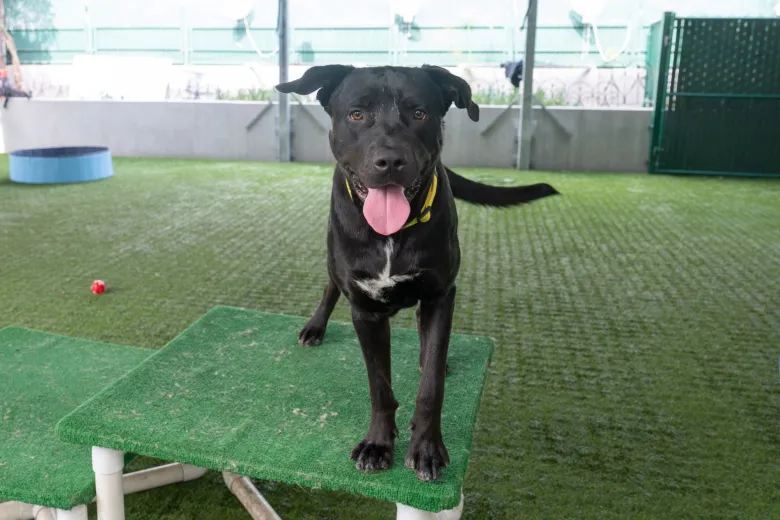Tips for keeping pets safe, less stressed, in July 4th ‘fireworks’ season

Every year, Pasadena Humane and other shelters receive an influx of stray or lost animals around the 4th of July festivities. Two-year-old Grant (A522206), a black Labrador mix, was found running on a street in Pasadena. Grant is available for adoption at Pasadena Humane.
Last week, I had the honor of joining Pasadena officials to help our community safely prepare for the 4th of July. We gathered in the hills of Hastings Ranch, next to the ruins of homes destroyed by the Eaton Fire.
The location was a reminder of the very real dangers our community is facing as we head into fire season, but also a chance to talk about how fireworks affect our pets.
At my side was Coffee Bean, a 4-year-old adoptable husky. We were both thrilled to hear that drones will be replacing fireworks at this year’s iconic Rose Bowl 4th of July show.
Fireworks have long been a cherished part of Independence Day. But it will come as no surprise that they are frightening for our pets, as well as local wildlife. The sudden booms and bursts cause many dogs and cats to panic, with more escaping their homes than any other time of year.
My own pets aren’t fans. As soon as they hear explosions, they go into alert mode, then search for a place to hide. Unfortunately, the noise follows them, even into their safe spots.
About five years ago, my wife and I decided that the 4th of July would be a holiday we spend at home. We’ve noticed that our pets feel better having us home when the fireworks begin.
We offer them a safe place in our bedroom and our veterinarian prescribes a mild medication. We close the windows, order in, and make it a movie night.
In preparation for the big day, we have a yearly routine where we ensure that all our pets’ microchips have our current phone numbers and address. “Checking the chip” will be especially important this year because we just moved.
Just like our family prepares, there are a few simple steps every pet owner can take to help keep your pets safe during the 4th of July holiday
ID is essential: Make sure your pet is wearing a collar with a current ID tag and are microchipped. This is their best chance at a quick reunion.
Keep pets indoors: The safest place for your pet is inside your home, preferably with you. Never bring pets to fireworks displays.
Create a safe space: Your pet may benefit from being kept in a quiet room, ideally away from windows. Set out comforting items like blankets, beds and their favorite toys, as well as a crate they can hide in.
Use calming tools: Playing soft music, giving calming treats, or trying a ThunderShirt may help relax your pet. You may also ask your veterinarian if medication may be appropriate.
Keep busy: Distract and tire out your pup by walking them earlier in the day (while being mindful of high heat) and providing chews, interactive toys or puzzle feeders to keep them occupied in the evening.
Even with best-laid plans, your pet may still go missing. Acting quickly is key. Immediately begin searching your home. A scared pet may have found a secure hiding place under your bed, behind the couch, or in a dark closet.
If your pet is still missing, begin to search the neighborhood and alert your neighbors. Your pet likely hasn’t traveled far.
Begin looking online. The lost and found page on our website is updated every hour with new shelter arrivals. Search for and post your missing pet on sites like Petco Love Lost and Pawboost, as well as Nextdoor and your neighborhood Facebook groups.
Together, we can make this 4th of July safer and less stressful for both people and pets alike.
For more safety tips and lost and found resources, visit pasadenahumane.org
Chris Ramon is interim president and CEO of Pasadena Humane. pasadenahumane.org
This blog post originally appeared as a column in the Pasadena Star-News on June 27, 2025.


